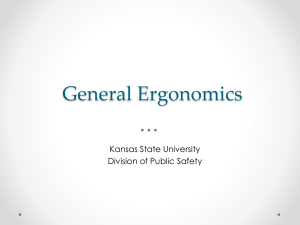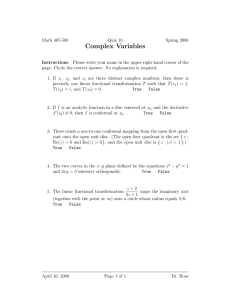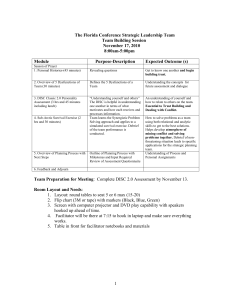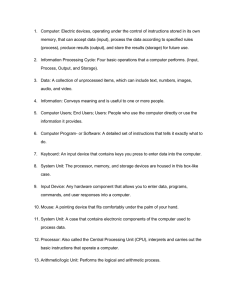Safe Lifting is Not an Accident Kansas State University
advertisement
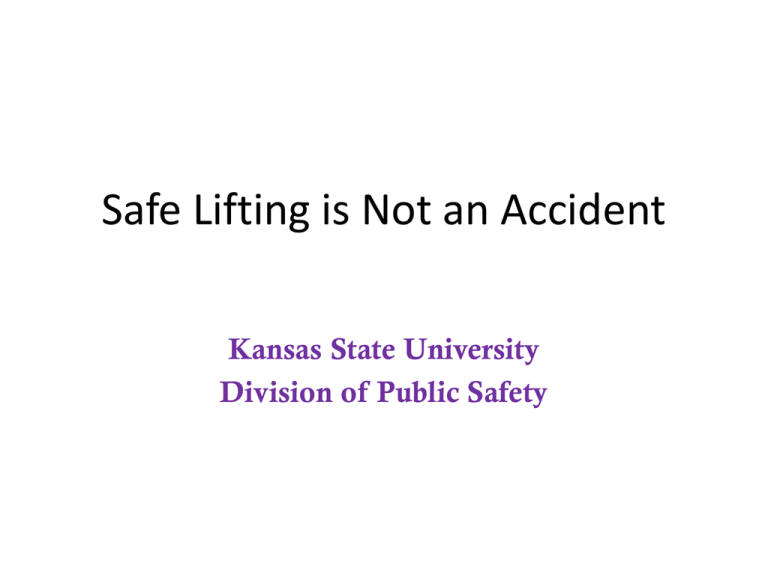
Safe Lifting is Not an Accident Kansas State University Division of Public Safety Objectives for Today • Lever Arms and Lifting • Basic understanding of the spinal column • Functions of the disc • Bending – Twisting – Loading • Keys to safe lifting • Get a grip!!! Injury in the making How to Injure Yourself Cumulative Trauma • Daily stress to the body • When exposed to high risk activities • If stress > bodies ability to recover • Result is inflammation • Long term exposure = cumulative trauma Cumulative Trauma Risk Factors • Repetition • Forceful exertion • Awkward and/or sustained postures • Mechanical Stress The Bottom Line The goal of ergonomics is to make an activity easy and safe to perform. We need your help • • • • • • Prevention Early Intervention Training Implementation Eyes on the floor Feedback Level Arms & Lifting Low Back Pain • Review of the anatomy – normal curves – bony columns – function of the disc – spinal cord & nerve roots – degenerative issues • Maintain the balance Normal Curves of the Spine The Spine & Nerve Roots Columns of Support • Posterior column of support – made up of the facet column – very stable – reflects an upright posture • Anterior column of support – made up of body of vertebra and the disc – less stable – reflects a flexed posture The Disc & Never Root • The disc is the shock absorber of the spine • 85% water at the age of 15 • 25% water at the age of 75 Degenerative Disc The Mechanics of Forward Bending Forward Bending • Too much spinal flexion – loads the anterior column of support – places the posterior wall of the disc at risk – has the potential for nerve root compromise Bulging Disc Herniated Disc The Issue of Flexion • Avoid excessive flexion of the spine • Flexed postures increases your risk of disc and nerve root involvement • Maintain up-right postures - not back bends... • Think posture Safe Lifting • Up-right neutral posture • Posterior column of support • Stable = less risk of injury Avoid Twisting Disc Pressure • • • • • Lying flat: disc pressure equals 25 psi Standing: disc pressure equals 100 psi Sitting erect: disc pressure equals 100 psi Sitting slouched: pressure equals 150-175 psi Lifting 25# box from the floor in a flexed posture: disc pressure equals > 400 psi Balance the Curves Work Smart-Not Hard… Test Your Loads- Seek Help Consider Different Choices Having a Bad Day??? Safe-Lifting is Not an Accident • Avoid spinal flexion • Avoid twisting • Avoid increasing disc pressure • Avoid reaching • Maintain up-right neutral postures • Hips = shoulders • Elbows at your sides • Keep the load close to your body Get a Grip… Anatomy of a Tendon Tendonitis • Tendon function: transmit force from muscle to bone • Micro tears of tendon occur daily • Typically repair themselves • With repeated loading repair is not adequate • Pain / Inflammation Influences on Your Grip • Required physical effort – Type of grip – Object weight – Distribution of weight – Object dimension – Required posture – Duration of effort Pinch and Posting Grip Getting a Grip in 110 DeQuervain’s Syndrome A More Appropriate “C” Grip Balance the Load So, How Strong are you? We’ve Been Here Before • • • • • • Prevention is the key Early intervention Keep it simple ….. We will get to difficult Think neutral postures Decrease heights Shorten “lever arms” In Closing… Where do we go? Slow Down Stop and assess the situation Don’t be afraid to get some help Listen and pay attention
